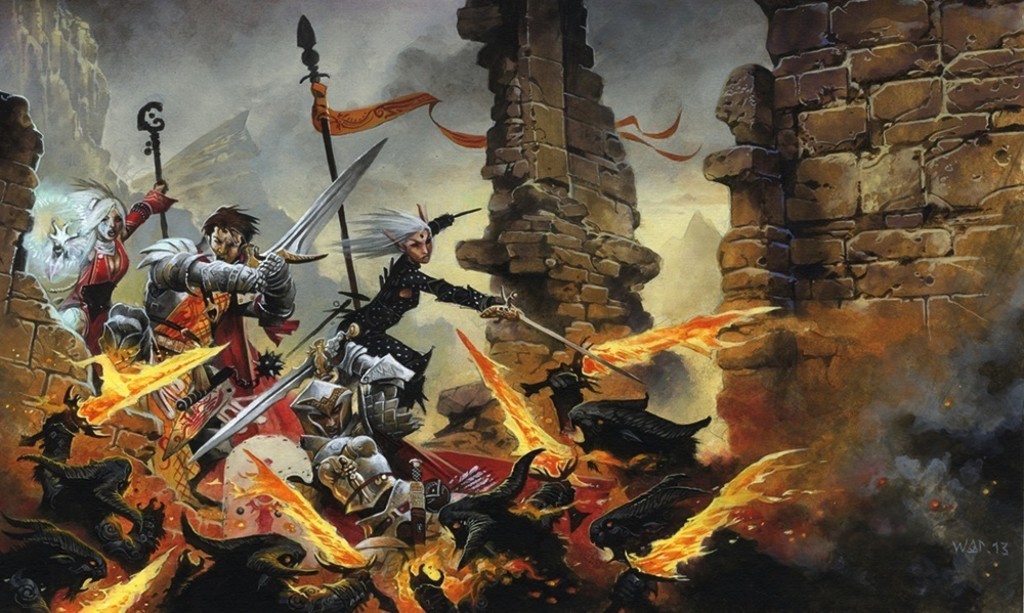Done by the book, you can easily spend 2 hours making up just one character in Pathfinder or D&D, even with software like Hero Lab to help. While this might be acceptable for a player who has just one character to make up, the poor DM who wants to make up a whole party of NPCs might need to spend 8 hours!
But before we discuss quick stats for NPCs, let’s first discuss the NPC party itself.
1. NPC party’s primary and secondary mission
Why does this NPC party exist? Who are they working for? What are their primary and secondary missions? This will help fit the NPC party in with the campaign’s plot.
Example: The NPC party are members of the Mercati, a smuggling operation based in the Badlands. Their primary mission is to smuggle some goods through the Badlands, so their merchant client can avoid Baron Imoldo’s onerous import tariff. Their secondary mission is to oppose any Impuniti, a rival group, they might meet along the way. The PCs run into them by chance while exploring the Badlands. To add spice, the NPC party mistakenly identifies the PCs as Impuniti and draw their weapons.
2. NPC party’s primary and secondary archetype
I define “character archetype” as a specific class (or subclass) along with either a specific gender, a specific race, or both. All characters with that archetype have those same characteristics, but can be of varying levels.
Each NPC party should have primary and secondary archetypes, and they should make sense for the party’s mission.
Example (cont’d): The NPC party’s primary archetype is human smuggler (rogue). Its secondary archetype is human scout (ranger). Gender is not specified for either archetype. The smuggler(s) handle the financial and law evading aspects of the mission: forging papers, sneaking into the destination city, and selling the smuggled goods on the black market. The scout(s) lead the way through the Badlands, help the party survive the rough terrain, and look out for enemies with their keen senses.
3. The party leader.
The leader of the party has the highest level and always has the primary archetype for the party. If you want the NPC party to be a challenge for the PCs, make the level of the NPC leader the same as the highest level PC.
Example (cont’d): The PCs are averaged at 5th level. The highest level PC is 6th. So we make the leader of the NPC smuggling party 6th level also. He/she has the primary archetype of human smuggler (rogue).
If race is not part of the primary archetype, roll for the race of the NPC leader:
Table 3.1: Race of NPC leader (d10):
1-5: Human
6-7: Elf or half-elf
8: Gnome or halfling
9: Half-Orc
10: Dwarf
If gender is not part of the primary archetype, roll for the gender as follows:
Table 3.2: Gender of NPC leader (d8):
1-5: Male
6-8: Female
Example (cont’d): Race (human) is part of the primary archetype for the NPC party, but gender is not. So we roll for the leader’s gender. We roll a “7”, so the leader is a female human.
4. Additional NPCs
Number and Level
First, roll 1d4 to decide how many additional NPCs there are. This will create a fairly small party, so adjust upwards if desired.
Next determine the level of each of these NPCs. If the leader is 5th level or higher, subtract d4-1 from the leader’s level to determine the level of each of the other characters. If the leader is 4th level or lower, subtract d3-1 from that level (minimum 1st level).
Example (cont’d): We roll a 3 on a d4, so there are 3 additional NPCs besides the leader for a total of 4 members in the NPC party. Since the leader is 5th level or higher, we roll d4-1 and get 3, 3, and 2 levels lower than the leader. So the additional characters are 3rd, 3rd, and 4th level.
Class
Next, determine the class of each additional NPC. There must be at least one party member with the secondary archetype, though it need not be the NPC with the second highest level. Determine the class of additional NPCs as follows:
Table 4.1: Class of additional NPCs (d20):
1-5: Class from primary archetype
6-9: Class from secondary archetype
10-11: Mage type (wizard, illusionist, or sorcerer)
12-13: Cleric type (cleric or druid)
14-17: Fighter type (fighter, warrior, paladin, ranger, or barbarian)
18-19: Rogue or bard
20: Aristocrat, expert or commoner
Example (cont’d): The first additional character (3rd level) is of the secondary archetype (don’t need to roll since we must have one). So he is a 3rd level scout (ranger). For the second additional member, we roll a “20”, so we decide he’s a 3rd level expert (the merchant client whose goods are being smuggled). For the third additional NPC, we roll a “12”, so a cleric type. Since its an outdoorsy party, we decide its a druid.
Race
If you rolled an archetype on Table 4.1 and race is part of the archetype, use the race for that archetype. Otherwise, roll for race using Table 3.1 above.
Gender
If you rolled an archetype on Table 4.1 and gender is part of the archetype, use the gender for that archetype. Otherwise, roll for gender using Table 3.2 above.
Re-roll race and/or gender if you get results that seem odd for your campaign, such as a halfling barbarian.
Example (cont’d): The scout is an archetype that specifies human, so we don’t need to roll for race. But we must roll for race for the expert and the druid. The archetype doesn’t specify gender, so we roll gender for all three additional characters:
- 3rd level scout: Rolled “3” for gender. A male human.
- 3rd level expert: Rolled “4” for gender and “5” for race. A male human.
- 4th level druid: Rolled “7” for gender and “5” for race. A female human.
Summary
Now you know the purpose of the NPC party and its makeup: how many are in the party, their level, class, race, and gender.
In Part 2 of this series, we’ll discuss different techniques for quickly creating stats for each member of the NPC party.
In Part 3, we’ll cover quickly generating equipment and treasure for the NPC party.
About the Author
Ed Larmore is a long-time GM of the Eraven Campaign. He is also the developer of Scabard, an RPG campaign manager.













